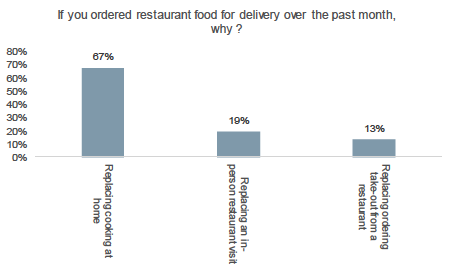As Wells Fargo sees restaurant delivery swelling to a $50 billion industry in the U.S. by 2022, the mega bank’s recent survey of 475 delivery consumers provides some insight on frequency, incrementality and the types of restaurants that have the most to gain.
In its survey of nearly 500 consumers who ordered restaurant delivery at least one time over the surveyed month, the most notable finding was that the bulk of its respondents ordered delivery less than five times in a month, and 28 percent ordered delivery only one time during the past month. That’s a lot of potential room for growth as delivery continues going mainstream in the U.S.
Asked if they were replacing cooking at home or an in-store restaurant visit, a heaping 67 percent of respondents said delivery replaced cooking a meal at home. Nineteen percent said it replaced a traditional restaurant visit, with 13 percent reporting that it replaced ordering take-out from a restaurant. That last stat might be most notable, as it suggests approximately 80 percent of the orders were incremental, meaning they did not replace trips to dine inside of a restaurant.
Most delivery watchers predict that such incrementality—the restaurant buzzword du jour—will decline over time as more consumers shift their spend toward off-premises channels.
DoorDash was the most common food delivery app on the phones of survey respondents, at 37 percent. Grubhub was second at 35 percent and Uber Eats was the third at 34 percent. “Other” came in at 25 percent, followed by Amazon at 21 and Postmates at 17 percent.
For restaurants, Wells Fargo Senior Analyst Jon Tower and Associate Analyst William Miller predicted that Chipotle, McDonald’s and Wingstop had the most to gain with incremental delivery business due to their strong technological backbone and “proper alignment with third-party delivery services.”
Showing that there’s ceiling to the number of restaurant apps consumers will install on their phones, 51 percent of Wells Fargo’s respondents have fewer than five restaurant-specific apps on their phones and 29 percent only had one restaurant-specific app.
“This supports our thesis that real estate on mobile devices is becoming more important,” the survey’s results concluded. “In order to be relevant to consumers, a restaurant’s app must work to reduce ordering friction or risk irrelevance,” which includes lower prices, ease of use, exclusive promotions or loyalty points.
Looking closer at consumers who ordered delivery more than five times in the surveyed month, these power users had a comparatively lower incident of pizza occasions, with Mexican and chicken-based choices showing higher uptake. This finding is likely being emailed around the offices of mega-pizza brands like Domino’s, Pizza Hut and Papa John’s that may lose share as the delivery ecosystem continues filling out with more cuisine choices in markets across the country.
The survey pointed to different strengths among delivery providers, with Uber Eats users reporting food variety, speed of delivery and ease of use were the most important requirements. Free delivery was of the highest importance for DoorDash users in the survey, which may contribute to that brand’s rapid gain in market share in recent months.
It’s worth noting that the survey participant demographics leaned more heavily toward older users with 34 percent answering that they were between the ages of 45 and 60. Those in the 30-34 bracket came in second, at 29 percent, followed closely by 18-29-year-olds who comprised 28 percent of the consumers in the survey.


